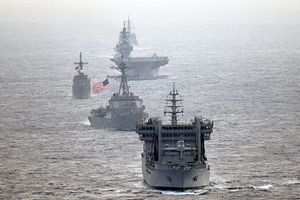Between May 2 and May 8, one of the most significant multilateral naval engagements in recent times took place in the South China Sea.
Warships from the United States Navy, the Japan Maritime Self-Defense Force, the Philippines Navy, and the Indian Navy sailed together for the first time in a four-way event demonstrating presence and cooperation.
Six vessels were present for the transit through disputed international waters in the South China Sea. The U.S. Navy’s Arleigh Burke-class guided-missile destroyer USS William P. Lawrence participated.
The Maritime Self-Defense Force sent the lead ship of the Izumo-class of helicopter destroyer, JS Izumo, in addition to JS Murasame, a destroyer. The Izumo has previously participated in joint exercises with the United States and India.
The Indian Navy, meanwhile, saw two warships returning to India from the Chinese People’s Liberation Army Navy’s recent fleet review join. INS Kolkata, a guided-missile destroyer, and INS Shakti participated in the exercise.
Before their participation in the Chinese fleet review, both warships also engaged in a bilateral exercise with Vietnam, which The Diplomat discussed in April.
The Philippine Navy sent BRP Andres Bonifacio, a patrol ship, to join the multilateral exercise.
“The ships conducted formation exercises, communication drills, passenger transfers and held a leadership exchange aboard JS Izumo,” a U.S. Navy 7th Fleet release noted.
“Events like this provide opportunities for like-minded navies to train together and promote maritime cooperation throughout a free and open Indo-Pacific,” it added.
While Japan and the Philippines are both U.S. treaty allies, India is not. But India has expanded its strategic partnership with the United States in recent years. Notably, New Delhi assented to trilateralize the previously bilateral Malabar series of naval exercises with the Maritime Self-Defense Force now a regular participant.
The recent South China Sea quadrilateral exercise underscores growing networking between countries partnered and allied with the United States. It marks the first engagement of its sort in the South China Sea and may presage similar operations in the future.
Aside from the Indian Navy’s participation in the recent South China Sea quadrilateral exercise, it is also participating this month in the Varuna 2019 bilateral naval exercise with the French Navy.
Last month, the Indian Navy also joined the Royal Australian Navy for a joint maritime exercise.
In recent years, China’s growing assertiveness in the South China Sea has been a source of concern from these countries. Beijing claims nearly the entire sea under its capacious nine-dash line claim.

































